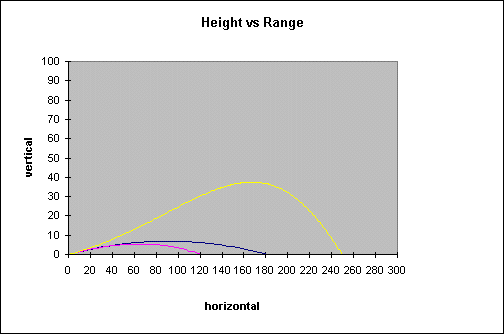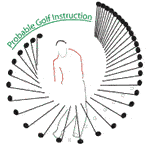How does temperature affect golf ball range?
The ball will fly less far at cooler temperatures for two reasons. Firstly, since the ball and club are cooler, the transfer of energy is not as efficient so ball speed will be less. Secondly, cooler air means more dense air so air friction will slow the ball down more and thus it will carry less far.
The denser the air, the less the distance. Imagine a ball moving through water, which is almost a thousand times as dense as air. The ball wouldn't go very far before stopping. When one compares hot air to cool air, the difference isn't as large as comparing water to air, but it is still enough to make a difference.
For an average golfer with swing speed around 90 mph, here are some comparisons between playing at 40 degrees F (4 deg C) and 80 degrees F (27 C).
Driver |
5-iron |
9-iron |
|
40 deg F |
203 |
157 |
108 |
80 deg F |
211 |
165 |
115 |
For a 9-iron, the difference is 7 yards, or about a full club. The same for a 5-iron. For a Driver, it's about 8 yards of carry, and then of course the difference in roll. Most courses at this time of year are much damper and thus there is very little roll, instead of the 20-40 yards roll one gets in the summer.
I'd recommend you hit one full club more on your shots. Most amateurs under-club to begin with. And, so that you don't get really frustrated, play a shorter set of tees during the late fall, winter and early spring months. That way, you'll be hitting similar approach irons to greens as you do in the summer.
Longer hitters lose even more distance on their shots. The penalty for not compensating is coming up even shorter.
In cool weather, you could also use a softer golf ball - men can go to ladies balls for lower compression. A low compression ball at lower temperatures will "feel" about like your normal ball. ie - the low compression ball cools and gets harder. Playing your "summer" ball will feel quite hard. Of course, your distances will still be shorter due to increased air friction drag.
If you'd like to send me your summer club ranges, I'd be happy to calculate your winter club ranges at for a range of temperatures (or vice versa). The fee is only $15.99. Use the Paypal link below and I'll email you for your yardages.
There has been some scientific testing to measure how much the "cold" effect is on your drives. Watch the youtube video below. The experimenters hit "cold" balls and "hot" balls. However, the balls were hit in warm air with warm clubs.
Golf is played in many different types of weather. The type of weather affects how far the ball travels and its amount of spin. Knowing how the weather conditions affect your ball, therefore, is necessary to making correct club selections.
The trajectory of a golf ball and the distance it travels depends on its initial trajectory, speed and spin, as well as what it's moving through (air). The air is not always the same. It varies in temperature, pressure, humidity and density. If there were no air whatsoever, the golf ball would not travel far. Likewise, if a ball is hit in air with no spin, it will not travel far. Check out the graph below of a golf ball hit with a driver under 3 different conditions.

Note first of all that the horizontal and vertical scales are quite different so as to depict clearly the differences in the conditions.
Under normal conditions, the air does not change very much, but the amount can be significant and should be taken into account, otherwise your ball will fall too short or too long of its mark. Below is a table of distances for a 5-iron and Driver under different atmospheric conditions.
 |
5 degrees 100% humidity | 20 degrees 50% humidity | 35 degrees 80% humidity |
| Driver | 244 yd | 250 yd | 262 yd |
| 5-iron | 168 yd | 175 yd | 182 yd |
Try out my Distance Calculator . You can input different conditions to see how they affect your tee shots.
| Note that temperature is in degrees Celcius. On the Fahrenheit scale, the temperatures would be 41, 68 and 95 degrees respectively. The distances also depend on the air pressure which not only depends on temperature and humidity but also on altitude. Hot and humid results in the ball travelling further. I provide a service to golfers who are interested in determining how the weather will affect their shots. If you'd like to purchase this service, click the Order Services option. You can determine the effects of temperature, wind and elevation. |
You'll receive a matrix of your club ranges in the format below, with your normal yardages for 70 F and then your yardages calculated for warmer and colder temperatures.
| Temperature (F) | 30 | 40 | 50 | 60 | 70 | 80 | 90 | 100 |
| Driver | 252 | |||||||
| 3-wood | 230 | |||||||
| 5-wood | 219 | |||||||
| 2-iron | 205 | |||||||
| 3-iron | 195 | |||||||
| 4-iron | 185 | |||||||
| 5-iron | 175 | |||||||
| 6-iron | 165 | |||||||
| 7-iron | 155 | |||||||
| 8-iron | 145 | |||||||
| 9-iron | 135 | |||||||
| PW52 | 120 | |||||||
| PW56 | 105 | |||||||
| PW60 | 95 | |||||||
| SW | 85 |
See and order all or my products at my golf product order (click HERE) page.


















